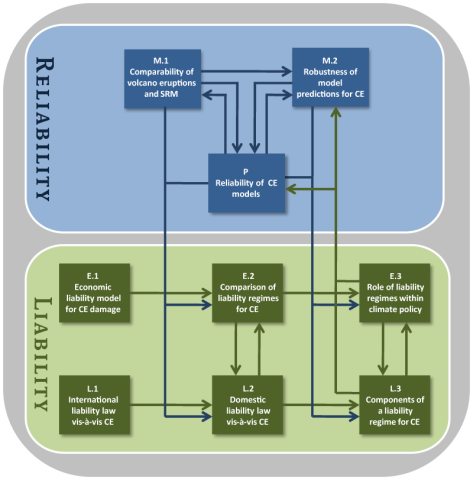
CEIBRAL
Climate Engineering Impacts: Between Reliability and Liability
- Prof. Dr. Martin Carrier // Bielefeld University // PI
martin.carrier@uni-bielefeld.de - Prof. Timo Goeschl, Ph.D. // Heidelberg University // PI
gt8@ad.uni-heidelberg.de - Prof. Dr. Alexander Proelß // Trier University // PI
proelss@uni-trier.de - Dr. Hauke Schmidt // Max Planck Institute for Meteorology, Hamburg (MPI-M) // PI
hauke.schmidt@mpimet.mpg.de - Dr. Ulrike Niemeier // MPI-M
- Tobias Pfrommer // Heidelberg University
- Barbara Heintz // Trier University
- PD Dr. Johannes Lenhard // Bielefeld University
- Jule Siegfried // Trier University
Project Description
Large-scale trials or actual deployment of Climate Engineering (CE) require an international legal framework. One important part of such a framework is the question of how to distribute the risks among the parties involved.
Problems regarding the distribution of risks are often resolved by liability regimes. However, the challenges in the context of CE are new in many respects: There is no historic experience with CE regarding time, place and scale of deployment. Due to the spatial and temporal complexity of the weather and climate system it will in general not be possible to link specific damages conclusively to CE activities. When standard risk management on the basis of experience-based model predictions is not feasible other conceptual approaches for assessing the reliability of CE projections have to be employed. Such reliability assessments require a deep methodological analysis of climate models and their application.
This project brings together climate modelers, economists, legal scholars and philosophers to explore the core issues of Reliability and Liability this problem.
|
|
||
K E Y Q U E S T I O N S
|
||
|
||
|
||
|
||
Methods
By comparing different results from the climate models within the Geoengineering Model Intercomparison Project (GeoMIP) the robustness of climate predictions with regard to different SRM methods will be assessed. Robust predictions will be analyzed with respect to underlying physical processes in order to underpin them by theory. Additionally, the extent to which CE climate predictions can be evaluated by means of volcano eruptions, serving as a natural experiment, will be explored.
The epistemological challenges will be approached by a particular close cooperation between climate modelers and philosophers through an “embedded philosopher”.

The standard model for liability will be adjusted to the case of CE where especially the reliability of climate models plays a central role. Based on that model different liability regimes will be assessed with regard to equity and efficiency issues. The ensuing necessary demands on a liability regime for CE interventions will be related to existing law and it will be argued in what way international liability law should be developed further in order to meet the challenges set by CE.
Stratospheric aerosol injection will be used as a model case und serves as a reference point for the discussion of other CE measures.
